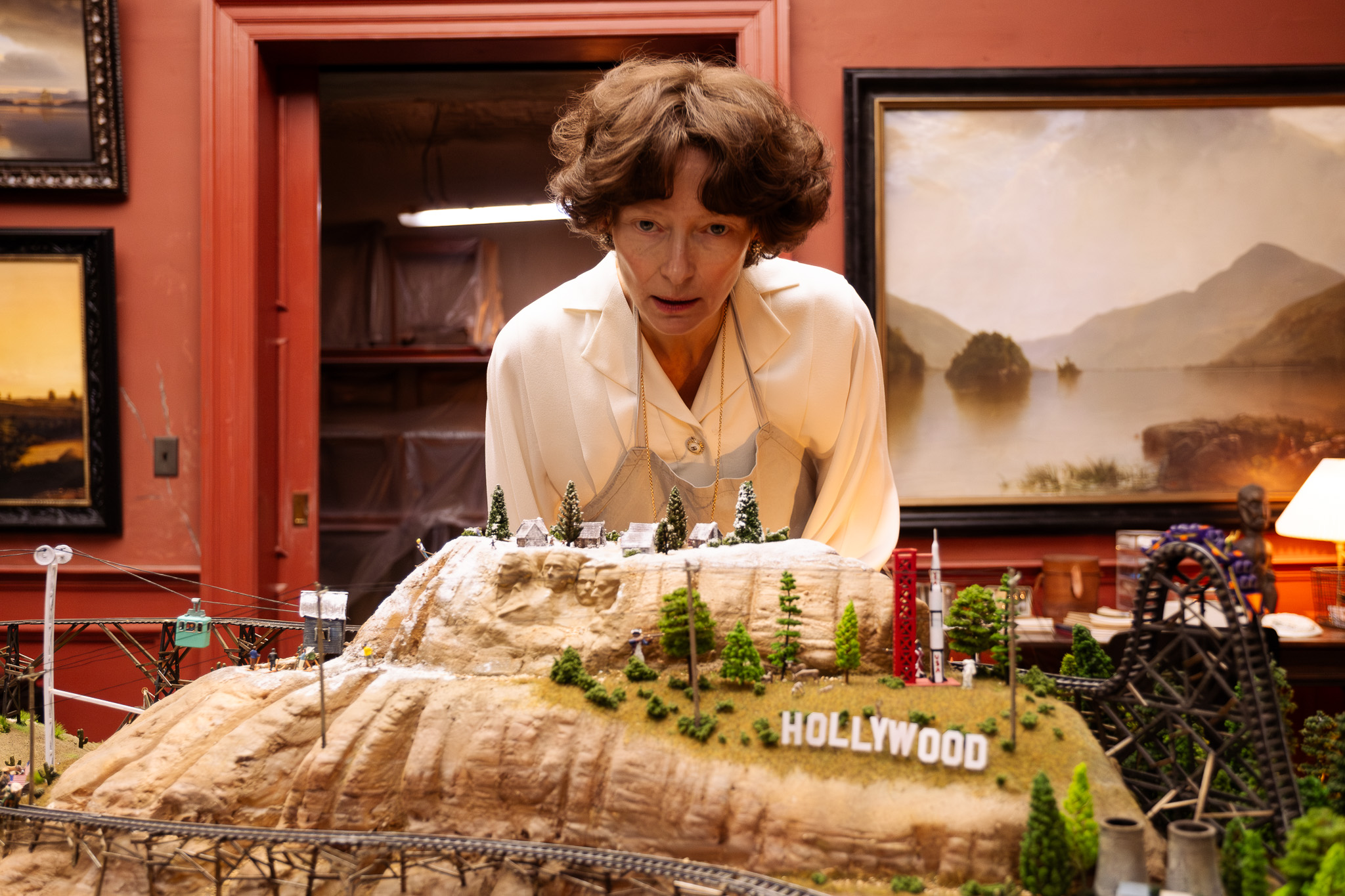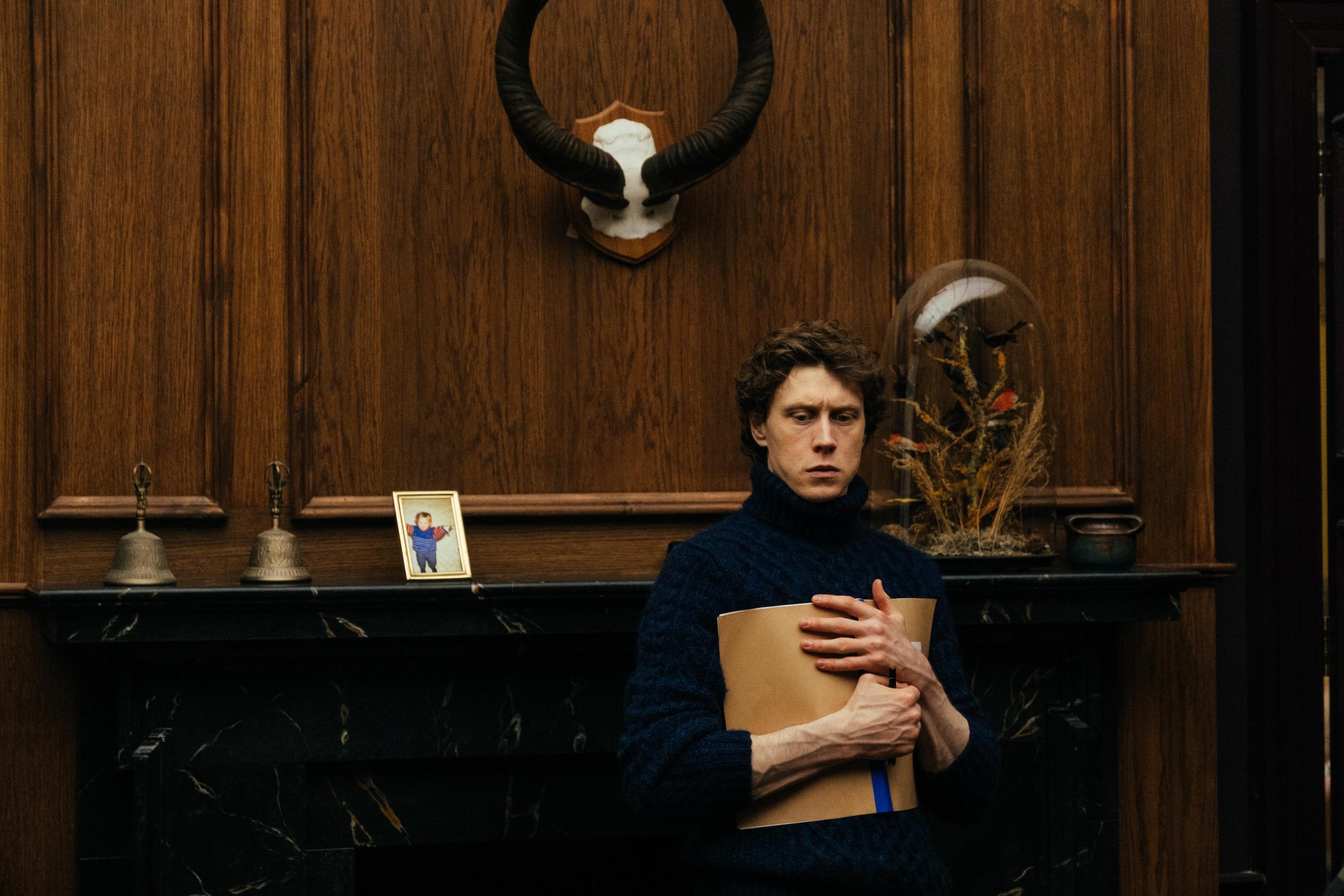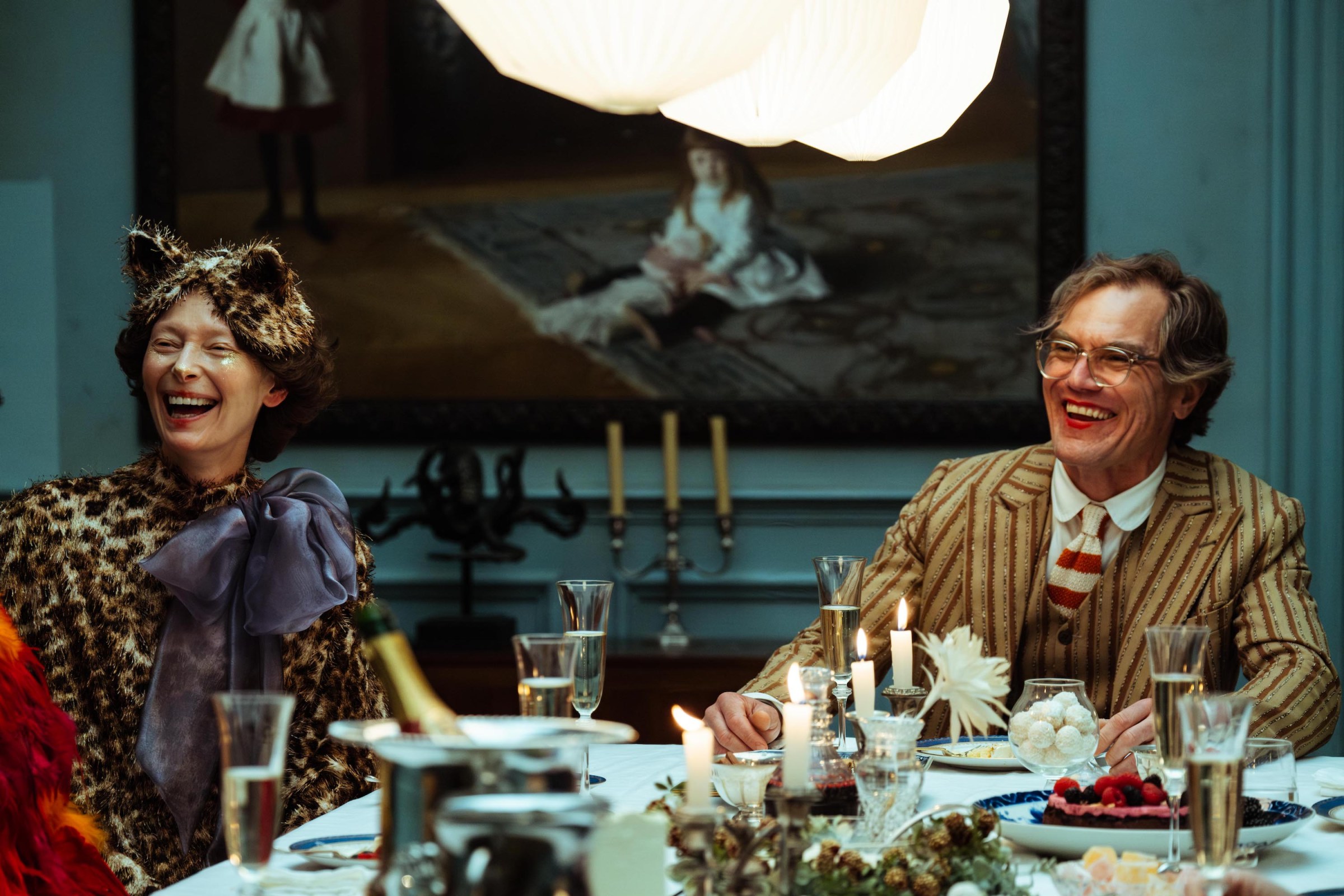This early review of The End comes from the Toronto International Film Festival. It will be updated for the movie’s December 2024 theatrical release date.
When The End begins, a wealthy industrialist family of three (Tilda Swinton, Michael Shannon, and George MacKay) have been living in a spacious underground bunker with their helpful staff for 20 years, as society crumbles above them. Humanity is all but lost. But the arrival of a mysterious survivor forces them to question their rules, and the stories they tell themselves about their own part in the global apocalypse. More often than not, they do this through song and dance.
In a bizarre but effective meld of genres and styles, the razzle-dazzle of golden-age Hollywood meets the grim dystopia of Children of Men. Trust documentarian Joshua Oppenheimer to make the world’s bleakest musical; as the director behind The Act of Killing and The Look of Silence, a pair of vital, harrowing works on the Indonesian genocide of the 1960s, it couldn’t have gone any other way. The result is a claustrophobic introspection into guilt and remorse, which hardly sounds like fitting material for a grandiose movie musical. But Oppenheimer’s focused approach to human drama makes it sing.
When we award the Polygon Recommends badge, it’s because we believe the recipient is uniquely thought-provoking, entertaining, inventive, or fun — and worth fitting into your schedule. If you want curated lists of our favorite media, check out What to Play and What to Watch.
The central cast plays easily identifiable types, each so broad that their characters aren’t even given names: The credits simply list them as Mother (Swinton), Father (Shannon), and Boy (MacKay). This last stronghold for humanity revolves around this trio. Mother is often weary and on edge; she’s tired of the life she has, but she understandably has no other recourse. So she spends her time fixing and fiddling with the many famous impressionist paintings she brought with her decades ago, moving them from wall to wall in her lavish living room until things feel just right.
Father, meanwhile, takes his mind off his loveless marriage by penning his autobiography, which concerns his part in the climate crisis that pushed humanity over the edge. However, he insists that his good deeds outweighed his sins, and that he may not have been particularly culpable after all.
And then there’s Boy, who, unlike the movie’s other characters, has no memory or concept of the world above. This naive, awkward 20-something was born in the bunker, and all he knows are its decorated hallways, its efficient food-growing labs, and the handful of icy caverns that surround it. He’s a history buff who’s been taught to avoid complicated political entanglements, and his understanding of the world is entirely conceptual. So he breathes life into dioramas of human (specifically, American) achievement, from westward expansion to the moon landing.
Boy is also granted the film’s first musical number, which provides all kinds of aesthetic and conceptual whiplash. He sings optimistically about a sunrise, something he has never seen, and can only imitate by pointing a flashlight over his tiny figurines. The mid-20th-century orchestra builds, as it might for a standard hopeful “I Want…” number about a character’s dreams, but the crescendo never arrives, and Oppenheimer’s unbroken takes never flourish into full-on formal grandeur. Given the physical constraints of the bunker, they can’t.
Notably, this post-apocalypse setting is also tiered and highly utilitarian, given who resides at the top. The family is rivaled in number by their household help: their gourmet chef (Bronagh Gallagher), who all but raised Boy; their short-tempered physician (Lennie James); and their diligent butler (Tim McInnerny). But they have also ensured that the security once afforded to them by wealth and class continue to allow them a sense of control. When the stranger, Girl (Moses Ingram), finally stumbles into their den, her fate is in their hands, and her options are either to head back out into the cruel and empty world, or become part of what they call their “family” — meaning, join their ranks as a household servant. In this new world, serfdom is the only way to survive.
Once all this cruelty is established and accepted, Oppenheimer doesn’t grant the film any delusions of subversion, or of delivering justice. In The End, the stains of capitalism and class are a firm status quo, and the characters aren’t given much room to upset this established order.
But what follows is often a sense of personal reckoning, in small but powerful ways. Every character carries with them the burden of what they’ve had to do to survive, and they keep these emotions buried. However, Girl, a wanderer who’s been alone for some time, is eager (maybe a degree too eager) to verbalize and discuss the worst parts of herself, and the actions she most regrets, even if her choices have let her survive a little longer.
In the process, she forces Mother and Father to at least recognize that their compartmentalization, and their refusal to recognize their role in greater harm — to the world at large, and to their own loved ones — has led to the slow, steady corrosion of their souls.
These realizations are also expressed in the form of solo numbers as each character wanders the hallways alone. There are few duets in The End — the family’s walled-off approach to living out their days has led to the suppression of not just emotion, but honest human connection. But when Girl finally shows up, and she and Boy take a liking to each other, the film starts to bloom in minor ways, from mischievous, playful songs accompanied by bodies in abstract motion to a camera that subtly sweeps through space, capturing a greater sense of romance (and pomp and circumstance) through movement and framing.
Oppenheimer and cinematographer Mikhail Krichman work within the reality and the physical constraints of each space. Even the most overt, showy emotions never magically conjure an ensemble of dancers, preventing the sensation of fulfillment. However, the filmmakers work magic with their use of light and focus. There’s no use in questioning the reality or diegesis of sung dialogue, but since the movie lacks the sprawling stage space that might allow actors to weave in and out of conversations, or go from communicating with each other to delivering asides to the viewer, the film remixes this theatrical notion using cinematic tools: Characters remain clearly visible so long as they can hear and understand one another, but fall out of focus and fade into the backdrop as soon as one of them takes the proverbial spotlight, and begins expressing inner thoughts and desires that the others cannot (or will not) hear.
The bunker is, for the most part, a cold and unforgiving space, which runs entirely counter to the shimmering appearance of the golden-age Hollywood musicals that inspired The End’s orchestral sound. However, the characters’ longing for emotional connection often warps this color palette in subtle ways, allowing warmer tones and brighter lights to briefly fade in as the actors move through space. It’s dazzling and despondent all at once, which is entirely fitting for an Oppenheimer film.
In The Act of Killing, the director spent several years interviewing a real mass murderer who was proud of his crimes. He even made this controversial figure reenact his brutality through the lens of Hollywood genre (gangster pictures and the like), with a handful of colorful, eye-popping detours that resembled large-scale musicals. The idea of cinematic self-reflexivity as means to suppress and eventually challenge one’s actions has long been a part of Oppenheimer’s work, and in The Look of Silence, he provides an even riskier look at the narratives told by those in power, which help them wash their hands of their barbarity.
These ideas trickle down to The End as well. The film is physically limited by design, but it ends up emotionally sprawling, with vast, eerily quiet psychological detours that allow each character the room to wrestle with what they’ve done, before their acceptance (or more likely, their denial) takes the form of song.
Ultimately, what’s most disturbing about Oppenheimer’s use of musical form is that singing from the heart has long been considered a means of expressing emotional truth from deep within. Here, the characters most responsible for the state of the world refuse to reckon with what they’ve done — but they sing regardless, fulfilling the film’s stylistic obligations like automatons, struggling to arrive at the honesty that usually underlies the grand Hollywood musical. Few movies have ever been this dark while sounding so sweet.
The End will arrive in American theaters on Dec. 6.




